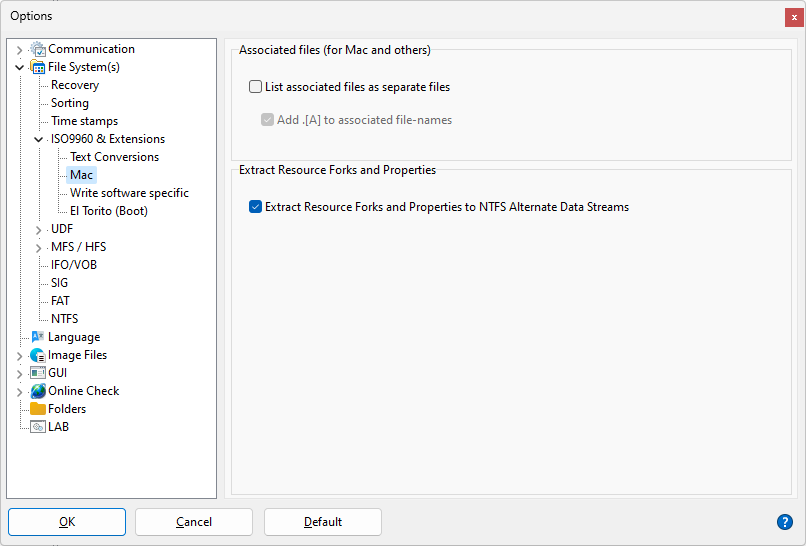ISO File System Settings (Mac)

Associated Files
Associated Files : The ISO9660 File System (also Joliet) can contain associated files. These files have the exact same name as the file they are associated with. Windows ignores these files but other systems often use them. E.g. Macintosh uses associated files to store the "Resource Fork" in. IsoBuster finds associated files and automatically keeps track of them when they contain Mac properties as part of the transparent Mac support. IsoBuster also extracts Mac Resource forks to an NTFS formatted Hard Disk, and stores them in Alternate Data Streams. These streams are not visible to the user browsing the file system with explorer, but they are there.
List associated files as separate files : You can however also set IsoBuster to display all associated files as separate files. This is independent from their content. Also non-Mac / non-Resource-Fork associated files are listed then.
Add .[A] to the associated file-names : Because associated files have the same file-name as the file they are associated with, they cannot be extracted (copied) to a Windows system in the same folder, as Windows does not accept two files with the same name in one folder. To be able to work around that easily and to be able to extract all files of a folder to a Windows system folder, you can have IsoBuster add an .[A] extension to the file name, to give the name a unique character.
Extracting Associated Files and/or Resource Forks as seperate files is basically not needed for anything except for engineering purposes. E.g. to be able to inspect the content and properties (e.g. size) of the Resource Fork; for designers, developers, engineers or technical people. IsoBuster transparantly takes care of what to extract to a Windows system, in case the file has Mac Properties, so that the file is usable on the Windows system. When you decide to extract files as MacBinary files, all Mac content is preserved, so that files can be exchanged on non Mac systems but when they are taken to a Mac System, Mac is able to re-create the two Forks and special Mac properties. MacBinary files are not understood by Windows, so can generally not be opened with any software, yet they are ideal for exchange purposes when files eventually need to end up on Mac systems again (e.g. sent via email).
Extract Resource Forks and Properties
Extract files with Mac properties as MacBinary files : Click here for an explanation on MacBinary files. [Removed in IsoBuster versions 5.2 and higher]
Extract Resource Forks and Properties to NTFS Alternate Data Streams :
Alternate Data Streams in an NTFS file system are a way to store extra metadata for a file, not in the file body itself, but in a stream that is attached to the file. In fact, these Alternate Data Streams resemble Mac "Resource Forks" in this respect. IsoBuster is able to convert the Resource Forks, that are stored in the ISO9660 (or derivatives) file system, to NTFS Alternate Data streams, in a way that a Mac, accessing the NTFS partition, is able to understand and use the Resource Forks and other Mac specific Properties again.
Scan options (normal mounting of discs)
Text conversions
Write software specific options
El Torito (Boot)